| ← Proteales, Buxales, Hamamelidales, Saxifragales |
Flora of New York — Vitales, Zygophyllales, Celastrales, Oxalidales | → Malpighiales (1) Hypericaceae, Podostemaceae, Elatinaceae | |||
| Table of contents |
Genus index |
Protected species index | Invasive species index | ||
Order Vitales
The order Vitales contains the single family Vitaceae.[1]
|
Family Vitaceae
The Vitaceae (grape family), in New York State, consists of Vitis (grapes), Parthenocissus (creepers), and Ampelopsis (porcelainberry)[1]
|
Vitis
Vitis riparia (river grape) |
| Vitis | Grape | N.Y. Status | Images | Distribution | NY NPT |
Michx. 1803. Vitis riparia Michx. 1856. V. cordifolia var. riparia 1893. V. riparia var. praecox 1897. V. vulpina var. praecox 1923. V. vulpina var. syrticola 1939. V. riparia var. syrticola 1949. V. vulpina ssp. riparia |
River grape, Riverbank grape, Frost grape Vigne des rivages, Vigne souvage, Raisin souvage |
Native, C:3, Secure FACW-FAC Perennial, Vine |
 |
NYFA-5 USDA-NN NPT Can ARS ITIS Trop. NSE BNA Images, wsp | |
Michx. 1803. Vitis aestivalis Michx. 1820. V. bicolor Raf. 1890. V. aestivalis var. bicolor 1897. V. argentifolia Munson 1921. V. lecontiana House 1924. V. aestivalis var. bicolor 1934. V. smalliana L.H.Bailey 1940. V. gigas J.H.Fennel 1936. V. aestivalis var. argentifolia 1987. V. aestivalis var. smalliana |
Summer grape, Small grape, Pigeon grape, Silverleaf grape, Blue grape Vigne d'été |
Native, C:4, Secure FACU Perennial, Vine |
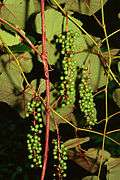 |
 |
NYFA-5 USDA-N0 NPT Can ARS ITIS Trop. Images, wsp |
L. 1753. Vitis labrusca L. 1818. V. labrusca var. labruscoides 1830. V. labrusca var. alba 1830. V. labrusca var. rosea 1940. V. labrusca var. subedentata |
Northern fox grape, Fox grape, Skunk grape, Concord grape Vigne lambruche, Vigne américaine, Vigne framboisier |
Native, C:6, Secure FACU Perennial, Vine |
 |
NYFA-5 USDA-NX NPT Can ARS ITIS Trop. Images, wsp | |
Fernald Vitis labrusca × Vitis riparia 1917. Vitis × novae-angliae Fernald |
New England grape, Pilgrim grape |
Native, Very vulnerable FACW-FAC Perennial, Vine |
 |
 |
NYFA-2 USDA-N0 NPT Can ARS ITIS FNA BNA Images, wsp |
L, 1753. Vitis vulpina L. 1803. Vitis cordifolia sensu Macoun non Michx. 1818. Vitis cordifolia var. vulpina 1891. Vitis vinifera var. vulpina 1934. Vitis illex L.H.Bailey |
Winter grape, Frost grape Vigne des renards
Vigne des battures
|
Native, C:5, Endangered FAC Perennial, Vine |
 |
 |
NYFA-1 USDA-NN NPT Can ARS ITIS Trop. BNA Images, wsp |
Rehder Vitis aestivalis × Vitis riparia 1922. Vitis × slavinii Rehder |
Slavin's grape, Hybrid of Summer grape & River grape |
Native, Unranked Perennial, Vine |
 |
 |
NYFA-? Trop. Images, wsp |
L. 1753. Vitis vinifera L. |
European grape, Wine grape, Vinifera grape Vigne cultivée, Vigne |
Introduced from Eurasia, northern Africa, Not naturalized Perennial, Vine, shrub |
.jpg) |
 |
NYFA-X USDA-XX ARS Images, wsp |
Prince ex Jacques Vitis labrusca × Vitis vinifera 1822. Vitis × alexanderi Prince nom. nud. 1829. Vitis × alexanderi Prince ex Jacques 1830. Vitis × prolifera Raf. 1834. Vitis isabellae var. alexanderi 1923. Vitis × labruscana L.H.Bailey |
Concord grape, Hybrid of Fox grape & Vinifera grape |
Introduced, Not naturalized FACU |
 |
 |
NYFA-Xnn USDA-00 Images, wsp |
| Vitis (excluded taxa) | Grape | N.Y. Status | Images | Distribution | NY NPT |
(Engelm.) Millardet 1880. Vitis cinerea (Engelm.) Millardet
|
Graybark grape | N. America native southern U.S., N.Y. excluded |
 |
NYFA-XCLD USDA-N0 ARS Trop. Images, wsp | |
Vahl |
Catbird grape | N. America native southern U.S., N.Y. excluded |
 |
 |
NYFA-XCLD USDA-N0 NPT Images, wsp |
| Hybrid of Summer grape & Winter grape |
N. America native, N.Y. excluded |
 |
 |
NYFA-XCLD Trop. Images, wsp | |
Parthenocissus
 Parthenocissus quinquefolia Virginia creeper tendril The two North American creepers found in New York (Virgina creeper and thicket creeper) are very similar in appearence. Both have similar five-lobed leaves, but they differ in the way their tendrils attach to surfaces for climbing. Virgina creeper (P. quinquefolia) attaches using adhesive pads, allowing it to climb smooth surfaces such as smooth rocks and buildings, similar to the way Boston ivy climbs. The tendrils of thicket creeper (P. inserta) attach by twining around objects. |
| Leaflets | Habit | Tendrils | Fruit | Inflorescence | |
|---|---|---|---|---|---|
| P. quinquefolia Virginia creeper |
dull above, pubescent below |
high-climbing or on ground | several branches terminating with dilated adhesive discs | rare, smaller |
central axis with 25-200 flowers in panicled groups |
| P. inserta thicket creeper |
shiny above, glabrous below |
sprawling over ground or structures | few branches, no adhesive discs |
common, slightly larger |
dichotomously branched, 10-60 flowers |
| Parthenocissus North American clade |
Creeper | N.Y. Status | Images | Distribution | NY NPT |
(L.) Planch. 1753. Hedera quinquefolia L. 1803. Ampelopsis quinquefolia (L.) Michx. 1887. P. quinquefolia (L.) Planch. 1939. P. quinquefolia fo. hirsuta |
Virginia creeper, Five-leaved ivy, Five-finger Vigne vierge à 5 folioles, Parthénocisse à 5 folioles, Vigne vierge vraie, Vigne vierge grimpante |
Native, C:4, Secure FACU Perennial, Vine |
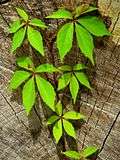 |
 |
NYFA-5 USDA-NN NPT Can iNat ARS ITIS Trop. BNA Images, wsp |
(A.Kern.) Fritsch 1887. Vitis inserta A.Kern. 1893. Ampelopsis quinquefolia var. vitacea 1894. P. vitacea (Knerr) Hitchc. 1922. P. inserta (A. Kern.) Fritsch |
Thicket Creeper, Woodbine, False Virginia Creeper Vigne vierge commune, Vigne vierge |
Native, C:2, Secure Perennial, Vine |
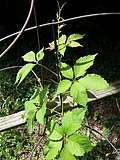 |
 |
NYFA-5 USDA-N0 NPT Can iNat ARS ITIS Trop. BNA Images, wsp |
| Parthenocissus Asian clade |
Creeper | N.Y. Status | Images | Distribution | NY NPT |
(Siebold & Zucc.) Planch. 1845. Ampelopsis tricuspidata S.& Z. 1868. A. veitchii hort. nom. inval. 1887. P. tricuspidata (S.& Z.) Planch. |
Boston ivy, Japanese creeper, Japanese ivy, Grape ivy Vigne vierge tricuspidée, Vigne vierge de Veitch, Vigne-vierge du Japon |
Introduced from temperate Asia, Potentially invasive Perennial, Vine |
 |
 |
NYFA-X USDA-XX NPT Can iNat ARS ITIS Images, wsp |
Ampelopsis
.jpg) Ampelopsis glandulosa (porcelainberry) |
| Ampelopsis | Peppervine | N.Y. Status | Images | Distribution | NY NPT |
(Wall.) Momiy. 1784. Vitis heterophylla Thunb.
1824. Vitis glandulosa Wall.
1859. Cissus brevipedunculata Maxim.
1845. A. heterophylla (Thunb.) Siebold & Zucc. nom. illeg.
1861. C. humulifolia var. brevipedunculata
1883. A. brevipedunculata (Maxim.) Trautv.
1887. A. heterophylla var. amurensis
1892. Vitis brevipedunculata (Maxim.) Dippel
1971. A. glandulosa (Wall.) Momiy.
1977. A. glandulosa var. brevipedunculata
1996. A. heterophylla var. brevipedunculata
|
Porcelain berry
Amur pepper-vine
Porcelain vine
Vigne vierge à fruits bleus
|
Introduced from China, Highly invasive, NYIS: 71%[1], Prohibited[2], NE-1[3] |
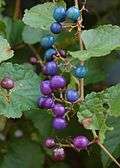 |
 |
NYFA-X USDA-X0 NPT Can ARS ITIS Trop. BNA Images, wsp |
Bunge 1833. Ampelopsis aconitifolia Bunge 1873. Vitis aconitifolia (Bunge) Hance 1884. Vitis serianiifolia var. aconitifolia auct. Ampelopsis cordata non Michx. (1803) |
Monk's-hood-vine | Introduced from China, Naturalized Perennial, Vine |
 |
NYFA-Xn USDA-X0 ITIS Trop. Images, wsp | |
| |||||
Order Zygophyllales
The Zygophyllales contain the two families Krameriaceae and Zygophyllaceae according to A.P.G. III (2009).[1]
|
Family Zygophyllaceae
The Zygophyllaceae (bean-caper or caltrop family) contains two exotic species that are not known to truly naturalize in New York but are of concern because they are listed as invasive in parts of North America.[1]
|
Subfamily Tribuloideae
Tribulus
_(11883835994).jpg) Puncture vine |
| Tribulus | Puncturevine | N.Y. Status | Images | Distribution | NY NPT |
L. 1753. Tribulus terrestris L.
1753. T. lanuginosus L.
1830. T. bimucronatus Viv.
1920. T. saharae A.Chev.
1946. T. terrestris var. sericeus (i)
|
Puncture vine
Puncture-vine
Puncture weed
Puncturevine weed
Caltrop
Small caltrop
Land caltrop
Goathead
Mexican sandbur
Texas sandbur
Croix-de-Malte
Tribule terrestre
|
Introduced from Eurasia, Africa, Australia, Impersistent, Naturalized Annual, Herb-forb |
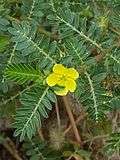 |
 |
NYFA-Xm USDA-Xw NPT Can ARS ITIS Trop. BNA CABI Images, wsp |
Subfamily Zygophylloideae
Zygophyllum
| The Syrian bean-caper (Zygophyllum fabago) is considered to be potentially invasive in parts of the U.S., but is not thought to have naturalized in New York.
|
| Zygophyllum | Beancaper | N.Y. Status | Images | Distribution | NY NPT |
L. 1753. Zygophyllum fabago L.
1867. Z. fabago var. brachycarpum
|
Caper-bean, Syrian beancaper, Syrian bean-caper |
Introduced from Eurasia, Impersistent, Not naturalized Perennial, Herb-forb |
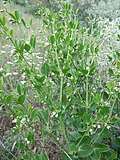 |
 |
NYFA-Xm USDA-X0 ARS ITIS BNA Images, wsp |
Order Celastrales
| The order Celastrales ...
|
Family Celastraceae
| The Celastraceae (staff-vine or bittersweet family) in New York contains the genera Euonymus (spindletree), Celastrus (bittersweet), as well as Parnassia (grass-of-Parnassus), which has also been included in the Saxifragaceae and Parnassiaceae.
|
Subfamily Parnassioideae
Parnassia
_(9754071813).jpg) Parnassia glauca common grass of Parnassus |
| Parnassia | Grass-of-Parnassus | N.Y. Status | Images | Distribution | NY NPT |
Raf. 1813. P. americana Muhl.
1840. P. glauca Raf.
auct. P. caroliniana non Michx. (1803)
|
Common grass of Parnassus, Fen grass of Parnassus, American grass-of-parnassus, Glaucous grass-of-Parnassus, "Carolina" grass-of-Parnassus Parnassie à feuilles glauques, Parnassie glauque |
Native, C:8, Likely secure OBL Perennial, Herb-forb |
 |
 |
NYFA-4 USDA-NN NPT Can ITIS Trop. NSE BNA Images, wsp |
L. 1753. Parnassia palustris L.
|
Marsh grass-of-Parnassus, Marsh grass of Parnassus, Northern grass of Parnassus, Meadow grass-of-Parnassus Parnassie des marais, Parnassie palustre |
Native, C:10, Likely extirpated OBL Perennial, Herb-forb |
 |
NYFA-U USDA-NN Can Trop. Images, wsp | |
| Parnassia (excluded taxa) | Grass-of-Parnassus | N.Y. Status | Images | Distribution | NY NPT |
Michx. 1803. P. caroliniana Michx.
|
Carolina grass of Parnassus | N. America native southeast U.S., N.Y. excluded OBL Perennial, Herb-forb |
_(16769662095).jpg) |
 |
NYFA-XCLD USDA-N0 ARS Trop. Images, wsp |
Subfamily Celastroideae
Euonymus
| Of the six native and naturalized Euonymus species in New York, three are native, and three have been introduced and are considered to be invasive.[1]
|
Euonymus subg. Euonymus sect. Euonymus
| The most common native Euonymus in New York is Euonymus atropurpureus (or eastern wahoo). It is sometimes confused with the somewhat-invasive Euonymus europaeus (or European spindle tree). The two can be distinguished by several characteristics, including:
|
| Euonymus atropurpureus (American wahoo) |
Euonymus europaeus (European spindletree) | |
|---|---|---|
| Leaves: | pubescent beneath or entirely glabrous | glabrous above & beneath |
| Petals: | wide, dark brown-purple | narrow, light green-yellow-white |
| Inflorescence: | umbels of 7-15 flowers | umbels of 3-8 flowers |
| Capsule: | pink to purple | red to pink |
| Aril: | scarlet | orange |
| Seed | brown | white |
| Euonymus L. subg. Euonymus sect. Euonymus | Spindletree | N.Y. Status | Images | Distribution | NY NPT |
Jacq. var. atropurpureus 1772. Euonymus atropurpurea orth. var. 1772. Euonymus atropurpureus Jacq. 1941. Euonymus atropurpureus var. cheatumii Lundell |
American wahoo, Eastern wahoo, Eastern spindle-tree, Burning bush, Bitter-ash Fusain pourpre, Fusain de l'Est |
Native, C:6, Likely secure FACU Perennial, Tree, shrub, Sun - part shade |
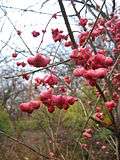 |
 |
NYFA-4 USDA-NN NPT Can ARS ITIS BNA LBJ Images, wsp |
L. Euonymus vulgaris Mill. |
European spindletree, European euonymus Fusain d'Europe, Bonnet de prêtre |
Introduced, Moderately invasive, NYIS: 60%[1], CP-5[2] Perennial, Tree, shrub |
 |
 |
NYFA-X USDA-XX NPT Can Images, wsp |
| |||||
Euonymus subg. Euonymus sect. Echinococcus
| Euonymus L. subg. Euonymus sect. Echinococcus | Spindletree | N.Y. Status | Images | Distribution | NY NPT |
Nutt. 1818. Euonymus obovatus Nutt. 1892. Eu. americanus var. obovatus |
Running strawberry-bush | Native, C:7, Vulnerable FAC-FACU Perennial, Shrub, subshrub, Vine |
 |
 |
NYFA-3 USDA-XX ARS Trop. LBJ Images, wsp |
L. 1753. Euonymus americanus L. 1753. Euonymus americana L., orth. var. |
American strawberry bush, Bursting hearts, Bursting heart |
Native, C:7, Endangered FAC Perennial, Herb-forb, Subshrub |
 |
 |
NYFA-1 USDA-N0 ARS Trop. NSE BNA Images, wsp |
Euonymus subg. Euonymus sect. Ilicifolia
| Euonymus L. subg. Euonymus sect. Ilicifolia | Spindletree | N.Y. Status | Images | Distribution | NY NPT |
(Turcz.) Hand.-Mazz. var. radicans (Siebold ex Miq.) Rehder 1851. Euonymus hederaceus Champ. ex Benth. p.p. 1863. Elaeodendron fortunei Turcz. p.p. 1865. Eu. japonicus var. radicans 1867. Eu. radicans Sieb. ex Miq. 1938. Eu. fortunei var. radicans Rehder |
Climbing euonymus, Winter creeper, Evergreen bittersweet, Climbing spindle-tree, Fortune's euonymus Fusain de Fortune, Fusain rampant |
Introduced, Highly invasive, NYIS: 78%[1], Regulated[2], CP-4[3] Perennial, Shrub, vine |
 |
 |
NYFA-X USDA-XX NPT Can ARS ITIS Images, wsp |
| |||||
Euonymus subg. Euonymus sect. Melanocarya
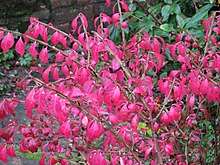 Euonymus alatus burningbush, winged euonymus |
| Euonymus L. subg. Euonymus sect. Melanocarya | Spindletree | N.Y. Status | Images | Distribution | NY NPT |
(Thunb.) Siebold 1784. Celastrus alatus Thunb. 1784. Celastrus striatus Thunb. 1826. Euonymus subtriflorus Blume 1826. Euonymus thunbergianus Blume 1830. Euonymus alatus Siebold |
Burning bush, Winged euonymus, Winged burning bush, Winged spindle tree Fusain ailé |
Introduced, Very highly invasive, NYIS: 81%[1], Regulated[2], CP-3[3] |
 |
NYFA-X USDA-XX NPT Can ARS Trop. Images, wsp | |
| |||||
Celastrus
 Celastrus scandens American bittersweet The two species, which are known to hybridize, can be distinguished by their inflorescences, which form at the ends of the branches of American bittersweet and at the joints (axils) of Oriental bittersweet. Also, the leaf margins of American bittersweet are finely toothed, while those of Oriental bittersweet are wavy. |
| species | common name | flowers | leaves | margins | seeds/capsule |
|---|---|---|---|---|---|
| C. scandens | American bittersweet | terminal arrays of >= 6 | L > 2W | fine teeth | 0 or 1 |
| C. orbiculatus | Oriental bittersweet | axillary arrays of 2 or 3 | L < 2W | wavy | >= 5 |
| Celastrus | Bittersweet | N.Y. Status | Images | Distribution | NY NPT |
L. 1753. Celastrus scandens L. 1794. Euonymoides scandens (L.) Moench 1902. Euonymus scandens (L.) E.H.L.Krause |
American bittersweet, Climbing bittersweet Bourreau des arbres, Célastre grimpant |
Native, C:7, Rare FACU Perennial, Vine |
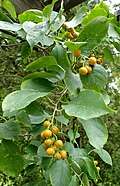 |
 |
NYFA-3 USDA-NN NPT Can ARS Images, wsp |
Thunb. 1784. C. orbiculatus Thunb. 1784. C. articulatus Thunb. |
Oriental bittersweet, Asian bittersweet, Asiatic bittersweet, Oriental staff vine Célastre asiatique |
Introduced from temperate Asia, Very highly invasive, NYIS: 87%[1], Prohibited, CP-2[2] NE-1[3] FACU-UPL |
 |
 |
NYFA-X USDA-XX NPT Can ARS ITIS Trop. Images, wsp |
| Celastrus (excluded taxa) | Bittersweet | N.Y. Status | Images | Distribution | NY NPT |
Loes. 1902. Celastrus gemmatus Loes. 1912. Embelia esquirolii H.Lév. 1935. C. lokchongensis Masam. |
Shrub-bittersweet, Chinese staff vine, Chinese bittersweet |
Introduced from temperate Asia, N.Y. excluded |
 |
NYFA-XCLD USDA-00 ARS FoC Trop. Images, wsp | |
| |||||
Order Oxalidales
| The order Oxalidales contains seven families, of which, only Oxalidaceae members have been discovered growing outside of cultivation in New York.
|
Family Oxalidaceae
| The Oxalidaceae (wood-sorrel family) has traditionally been included in the Geraniales, but is now included here with phylogenically similar Rosids. The only Oxalidaceae genus known to grow in the wild in New York is Oxalis.
|
Oxalis
| Oxalis (or wood-sorrel) species are not closely related to the several edible plants referred to as sorrel in the Rumex genus, and their visual appearance is quite different, but the taste of their leaves is said to be similar. Of the four Oxalis subgenera, only subg. Oxalis species have been found in New York.
|
Oxalis subg. Oxalis sect. Oxalis
 Oxalis montana - northern wood-sorrel |
| Oxalis sect. Oxalis | Wood-sorrel | N.Y. Status | Images | Distribution | NY NPT |
Raf. 1818. Oxalis montana Raf. 1930. O. acetosella var. rhodantha 1958. O. acetosella ssp. montana auct. O. acetosella non L. |
Northern wood-sorrel
White wood-sorrel
Mountain wood-sorrel
Sleeping-beauty
American wood-sorrel
Common wood-sorrel
Oxalide de montagne
Oxalide des bois
|
Native, C:7, Secure FAC-FACU Perennial, Herb-forb, Part shade |
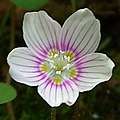 |
 |
NYFA-5 USDA-NN NPT Can ARS ITIS FNA Trop. NSE BNA IPN LBJ Images, wsp |
Oxalis subg. Oxalis sect. Corniculatae
Oxalis stricta common yellow wood-sorrel |
| Oxalis sect. Corniculatae | Yellow wood-sorrel | N.Y. Status | Images | Distribution | NY NPT |
L. 1753. Oxalis stricta L.
1854. Oxalis europaea Jord.
1896. Oxalis cymosa Small
1903. Xanthoxalis stricta (L.) Small
1903. Xanthoxalis cymosa (Small) Small
1943. Xanthoxalis europaea Moldenke
|
Common yellow wood-sorrel, Common yellow oxalis, Upright yellow wood-sorrel, European wood-sorrel, Tall wood-sorrel Oxalide d'Europe, Oxalide dressée, Oxalide stricte, Surette, Pain d'oiseau, Oxalis droit |
Native, C:0, Secure FACU Perennial, Herb-forb, Sun |
 |
 |
NYFA-5 USDA-NX NPT Can ARS ITIS Trop. BNA LBJ Images, wsp |
Jacq. 1794. Oxalis dillenii Jacq.
1897. Oxalis corniculata var. dillenii
1925. Oxalis stricta var. piletocarpa
1972. Xanthoxalis dillenii (Jacq.) Holub
|
Slender yellow wood-sorrel, Dillen's wood-sorrel, Sussex yellow sorrel Oxalide de Dillenius |
Native, C:0, Secure FACU Perennial, Herb-forb |
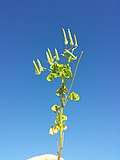 |
 |
NYFA-5 USDA-NX NPT Can BNA Images, wsp |
Salisb. 1796. Oxalis florida Salisb.
1803. Oxalis prostrata Haw.
1821. Oxalis recurva Elliott
1824. Oxalis dillenii var. florida
1825. Oxalis rupestris Raf.
1897. Oxalis filipes Small
1901. Oxalis brittoniae Small
1903. Xanthoxalis brittoniae Small
1903. Xanthoxalis filipes Small
1903. Xanthoxalis recurva (Elliott) Small
1943. Xanthoxalis florida Moldenke
1963. Oxalis dillenii ssp. filipes
1964. Oxalis florida ssp. filipes
1964. Oxalis florida var. recurva
1979. Oxalis florida ssp. prostrata
1987. Oxalis dillenii ssp. recurva
|
Southern yellow wood-sorrel, Flowering yellow wood-sorrel |
Native, C:0, Secure |
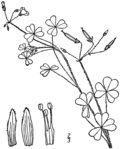 |
 |
NYFA-5 USDA-NX NPT Can-0 FNA Trop. Images, wsp |
L. 1753. Oxalis corniculata L.
1891. Acetosella corniculata Kuntze
1903. Xanthoxalis corniculata Small
|
Creeping wood-sorrel, Creeping yellow wood-sorrel Oxalide cornue, Oxalis cornu |
Introduced, US South native, (questionably) |
.jpg) |
 |
NYFA-X USDA-NX NPT Can ARS ITIS Trop. BNA Images, wsp |
Oxalis subg. Oxalis sect. Ionoxalis
 Oxalis violacea violet wood-sorrel |
| Oxalis sect. Ionoxalis | Bulb-bearing wood-sorrel | N.Y. Status | Images | Distribution | NY NPT |
L. 1753. Oxalis violacea L. 1782. Sassia tinctoria Molina 1891. Acetosella violacea (L.) Kuntze 1903. Ionoxalis violacea (L.) Small 1937. O. violacea var. trichophora 1943. I. violacea var. trichophora 1998. Sassia violacea (L.) Holub |
Violet wood-sorrel | Native, Threatened |
 |
 |
NYFA-2-3 USDA-N- NPT Can-0 ARS Trop. BNA Images, wsp |